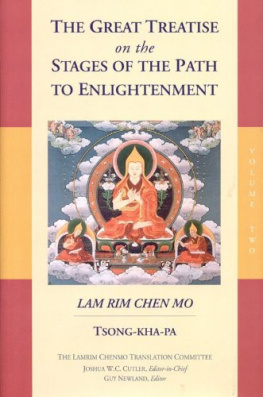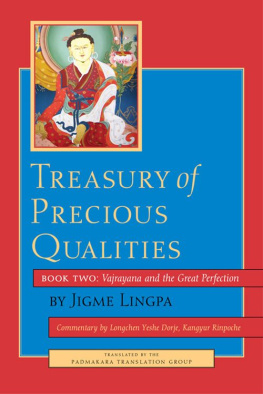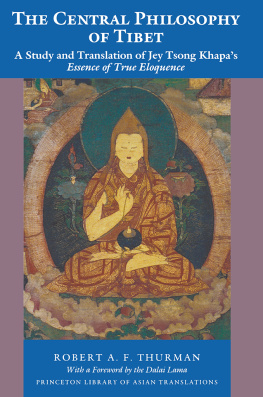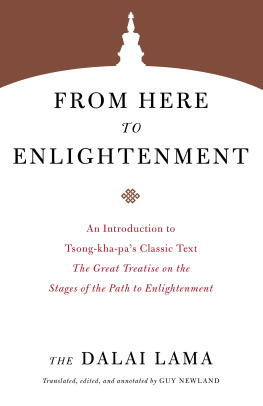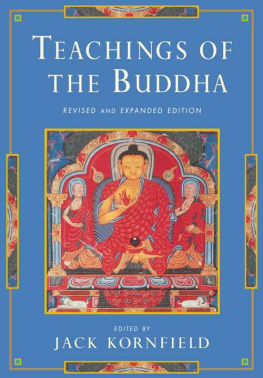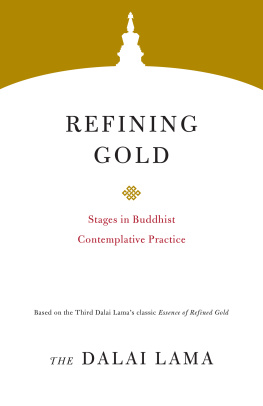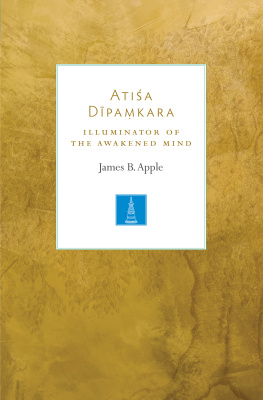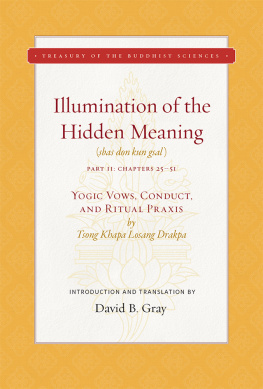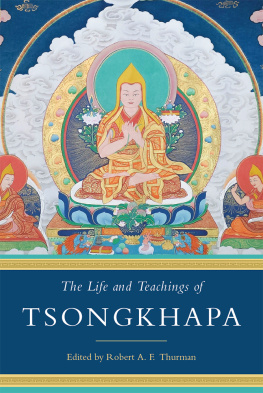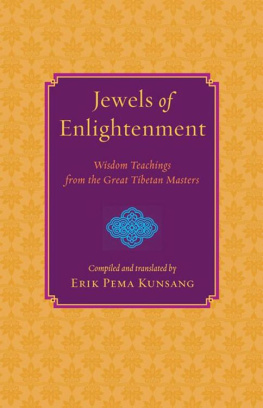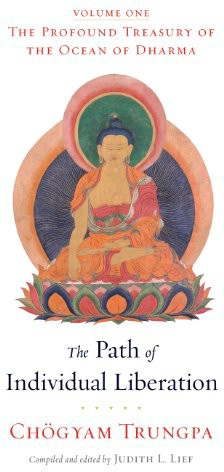Table of Contents
The Lamrim Chenmo Translation Committee
Jos Ignacio Cabezn
Daniel Cozort
Joshua W. C. Cutler
Natalie Hauptman
Roger R. Jackson
Karen Lang
Donald S. Lopez, Jr.
John Makransky
Elizabeth S. Napper
Guy Newland
John Newman
Gareth Sparham
B. Alan Wallace
Joe B. Wilson
Snow Lion Publications
605 West State Street
P. O. Box 6483
Ithaca, NY 14851
(607) 273-8519
www.snowlionpub.com
Copyright 2004 Tibetan Buddhist Learning Center
First edition USA 2004
All rights reserved. No portion of this book may be reproduced by any means without the prior written permission of the publisher.
Printed in Canada on acid-free, recycled paper.
ISBN 1-55939-168-5
Library of Congress Cataloging-in-Publication Data
Tso-kha-pa Blo-bza-grags-pa, 1357-1419.
[sKyes bu gsum gyi rnyams su bla bai rim pa thams cad tsha bar ston pai
bya chub lam gyi rim pa/ Lam rim chen mo. English]
The great treatise on the stages of the path to enlightenment / by Tsong-kha-pa;
translated by the Lamrim Chenmo Translation Committee ; Joshua W. C. Cutler,
editor-in-chief ; Guy Newland, editor.
p. cm.
Includes bibliographical references and index.
Volume 1 ISBN 1-55939-152-9 (alk. paper)
Volume 2 ISBN 1-55939-168-5 (alk. paper)
Volume 3 ISBN 1-55939-166-9 (alk. paper)
1. Lam-rimEarly works to 1800. I. Title.
BQ7950.T754.L34413 2000
294.3444dc21
00-044664
DEDICATION
We dedicate this translation to
His Holiness the Fourteenth Dalai Lama
and the people of Tibet.
EDITORS PREFACE
This book is the second volume in a three-volume translation of the Great Treatise on the Stages of the Path to Enlightenment (Byang chub lam rim che ba). It brings to a conclusion a project initiated by the Tibetan Buddhist Learning Center (TBLC) in 1992. Volume one was published by Snow Lion Publications in 2000 and volume three in 2002. Just as the location of this volume between the other two indicates, this middle volume is the heart of the Great Treatise. It covers the spirit of enlightenment (bodhicitta; byang chub kyi sems) and the deeds of the bodhisattvas, the great beings whose deeds are motivated by this altruistic spirit.
The Lamrim Chenmo Translation Committee has followed the same procedure and format that was used for volumes one and three, except for giving in the notes on the citations the Sanskrit reference and Tohoku catalogue (Ui et al. 1934) reference (identified by the abbreviation D) as supplied by Tsultrim Kelsang Khangkars critical edition of the Tibetan text. The committee members who worked on this volume were Natalie M. Hauptman, Gareth Sparham, Daniel Cozort, and John Makransky. These translators again used the Tso-ngn (mTsho-sngon) edition of the Lamrim chen mo published in Zi-ling by Tso Ngn Peoples Press in 1985 (bracketed numbers appear throughout this work). They also referred to the commentary Four Interwoven Annotations (Lam rim mchan bzhi sbrags ma) and used it consistently to interpret citations. The editors again had the invaluable assistance of the eminent contemporary Tibetan Buddhist scholars Denma Loch Rimbochay and Loling Geshe Yeshe Tapkay to read through the text and discuss difficult passages. Over the twelve years of this project the editors have come to appreciate what rare and precious treasures these two persons are.
While I was working on this translation project, I was often under the illusion that I was doing everything myself. However, as mentioned in this book, the distinction between self and other is not as sharp as we naturally think. Therefore, I would like to acknowledge the great contributions of others who have been as essential as myself in bringing this project to completion. In the prefaces to the other two Great Treatise volumes I have already thanked many people, and I hold their continued help in highest esteem. Yet I would be remiss if I did not give special thanks to a number of people whose contributions were especially beneficial to me over the past two years it took to complete this final volume.
I especially express my deepest gratitude to His Holiness the Dalai Lama, my constant source of inspiration for this work. His Holinesss activities embody the lofty ideals described in this book, such that he is the light of hope for those who desire peace in this strife-torn world. In response to my request His Holiness has said that He will give teachings at TBLC on the entire Great Treatise, and I pray that this great honor can soon become a reality. I am also continually grateful to my guru the late Geshe Ngawang Wangyal, whose profound effect upon my life has made him an ever-present source of support. As always, I greatly appreciate the efforts of the above-mentioned translators and Tibetan scholars. I would like to mention the two Tibetan scholars in particular. Geshe Yeshe Tapkay first proposed this project to me and has subsequently given his invaluable assistance without hesitation. Denma Loch Rimbochay has given me constant guidance and support. I am most indebted to the great kindness they both have shown me. Among the translators I especially appreciate all the extra efforts of Gareth Sparham, who edited the original manuscript, entered all the citation notes, and put together the bibliography. I am also very grateful to Guy Newland, whose cogent suggestions brought clarity to the translation. I am also thankful to Gray Tuttle and Brady Whitton for their thoughtful editing suggestions. And I am most grateful to Snow Lion editor Susan Kyser for all her kind efforts at doing a very careful job to avoid any discrepancies in the text. In addition, I thank Snow Lions Steven Rhodes for bibliographic help, and Jeff Cox and Sidney Piburn for their support and encouragement.
Also I would like to extend my great appreciation to all the family, friends, students, and supporters of TBLC who have given from their hearts to make this work possible: to my parents, Eric and Nancy Cutler, whose inestimable kindness I can never repay; to Buff and Johnnie Chace and their son, Ben, for their valued friendship and financial support; to my other friends and supportersAlexander Levchuk, Martha Keys, Pierroluigi Squillante, Mukesh and Sepna Sehgal, Sharon Cohen, Frank and Raksha Weber, Chip and Susan Carlin, Harvey Aronson and Anne C. Klein, Elizabeth S. Napper, Thao and Gai Nguyen, Al Bellini, Victoria Jenks, Jim and Bonnie Onembo, Nick and Shelley Guarriello, Pence and Joanie Ziegler, David and Victoria Urubshurow, Frank and Khady Lusby, Jane Bullis, Jim Mershon, Vera Krivoshein, Sally Ward, Chot and Armen Elliott, and Louise Duhaime; to some of the TBLC students for their supportAmy and John Miller, Jennifer Collins, and Thomas Santomartino; and to the TBLC doctorsPeter Beskyd, James Goodwin, Frank Viverette, Jerry Cohen, David and Ming Ming Molony, Davis Smith and Kendra Lawrence, and Robert Blease.
There is one person whose collaboration on this project has made everything possible. The nature of my responsibilities at TBLC are such that I would not have been able to put my fingers on the keyboard if it were not for my wife, Diana. Since the inception of this project, she has selflessly shouldered more and more of the duties that keep TBLC running smoothly, as well as helped me on this translation project whenever needed. Over the twelve years of this project it has been very difficult for me to keep on track, and it has only been possible because of Dianas deep dedication to our guru Geshe Wangyals vision, her boundless energy and enthusiasm, a consistent ability to put her own interests second, and a very practical intelligence. Just as an infant grows up in dependence upon the affection and support of its mother, so Diana has been the mother of this translation. For this I am eternally grateful.

